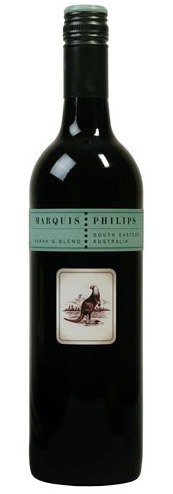Marquis Philips Sarah’s Blend
 Marquis Philips
Marquis Philips
Sarah’s Blend
McLaren Vale
2008
Vintage Notes from Chris Ringland
The weather in Southern Australia is profoundly influenced by one geographical feature; there is no land mass between Australia’s southern coasts and Antarctica. The progression of high pressure cells and cyclonic low pressure systems proceeds according to a fairly predictable six-day cycle. High pressure cells rotate counter-clockwise; low pressure, clockwise. This means that when the center of a high pressure cell is located over the Southern coastal wine growing regions as it approaches from the West, we experience cool, wet conditions due to cold air being directed up from the South Polar regions. As the cell progresses across South Eastern Australia to the Tasman Sea, the subsequent northerly airstream directs hot, dry air down from central and Northern Australia. Please excuse the meteorology lecture, but there is an important point to this. During summer and autumn (i.e. vintage) in Southern Australia, high pressure
cells are centered over the coastal regions and consequently, the swings between cool southerly airstreams and hot northerly airstreams can be extreme. This is quite normal and the transition from hot to cool conditions proceeds quite smoothly. But, what happens if the west-to-east progression slows down?
As described above, when the center of a high pressure cell is located over South Eastern Australia,
a hot airstream flows over South Australia. If the progression of this system is “blocked” by a low pressure system over the Tasman sea, then we have what is termed a “blocking high” and as you can deduce, the hot Northerly airstream continues to affect South Australia for a prolonged period. This is what happened in South Australia during vintage 2008. The build-up to vintage was very positive for a favorable outcome in South Australian vineyards. Reasonable winter and spring rains followed by mild early summer conditions resulted in good canopy growth and normal flowering and fruit set.
There was a short burst of extreme heat in early January 2008 and then conditions became unusually cool to mild for the rest of January and all of February. In retrospect, we should have seen it coming. For every hot northerly airstream there has to be a corresponding cool southerly airstream, and a protracted period of mild, cool weather would, sure as eggs, be followed by a heat wave. What no one predicted was how long the heat wave would last and, as luck would have it, the whole system stopped moving. Think of it as the meteorological equivalent of a traffic jam. The heat arrived on March 3 and continued through March 22, the longest single heat wave event in South Australia since reliable records were established in the 1880s.
Because of its strong coastal influence, McLaren Vale experiences milder weather conditions compared to inland South Australian regions like Barossa and the Riverland. As a consequence McLaren Vale vineyards tend to ripen earlier and therefore the impact of the heat wave was more extreme.
